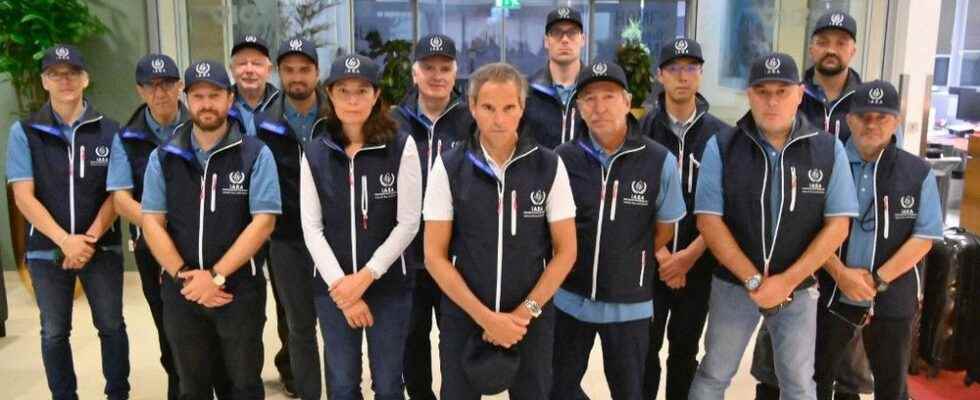A mission under very high tension. Led by their director, Rafael Grossi, the agents of the International Atomic Energy Agency (IAEA) who have gone to inspect the Zaporijia nuclear power plant are expected on site at the end of the week. Their objective: to check the condition of the installations, and their ability to operate despite past bombardments. If their presence on the site will not rule out any risk of nuclear accident, it will still make it possible to estimate the situation within the largest nuclear power plant in Europe, according to Karine Herviou, deputy director general in charge of the Security division. at the Institute for Radiation Protection and Nuclear Safety (IRSN). Maintenance.
L’Express: What will be the purpose of the mission of the IAEA inspectors at the Zaporijia nuclear power plant?
Karine Herviou: The IAEA mission serves to take stock of the situation on the site. Normally, inspectors from the Ukrainian safety authority are permanently present there, but this is no longer the case since the Russians took control of the plant in March. Telephone communications have been maintained, but there is still little visibility on how activities are taking place on site.
The IAEA will therefore seek to take stock of the various priorities. This includes in particular the state of the backup systems that allow the reactors to be cooled, the operating conditions of the power plant, but also the physical integrity of the latter. The objective will be to ensure that the plant’s operating rules, which guarantee the safety of the site, are well respected.
Concretely, how will this happen?
IAEA officials are expected to meet with staff from Energoatom, Ukraine’s national nuclear power generation company, which operates the plant, to ask them questions. They should also probably tour the facilities, to assess the impact of the various bombings that have hit the site in recent weeks.
In a nuclear power plant, many systems must be regularly tested to verify that they are functioning correctly. IAEA officials will ensure that all these checks are still possible. They will also try to answer a whole series of questions: are there still spare parts for maintaining the equipment? Or, are there still enough staff to operate the plant?
Can the dispatch of an IAEA team be sufficient to ensure the security of the site?
No, that cannot be enough to rule out any risk of a nuclear accident. Last week, the plant was completely disconnected from the electricity grid, yet a plant needs electricity to ensure its safety. We can see that the plant’s defense lines have been seriously weakened. However, this IAEA inspection will provide better visibility of the situation on site, and perhaps push for demilitarization of the area. Furthermore, the presence of IAEA agents on the site may possibly deter, at least temporarily, the bombings that have taken place in recent weeks.
International Atomic Energy Agency chief Rafael Grossi and his team of inspectors on their way to inspect the Zaporizhia nuclear power plant
@rafaelmgrossi Twitter / AFP
Can the plant’s reactors withstand bombardments?
The reactors are located in large cylindrical reinforced concrete buildings. Their role is to retain the radioactive products in the event of a serious accident at the level of the reactor core. But they also aim to protect the reactors against an external attack, such as a plane crash. These buildings therefore offer good protection to the reactor cores, even if they were not designed to ensure operation in a state of war and to withstand bombardments. On the other hand, other parts of the site, which contain far fewer radioactive substances, are less protected and therefore more vulnerable.
Precisely, the auxiliary systems making it possible to supply energy to the cooling systems of the reactors – such as the thermal power station nearby, or the power lines supplying the nuclear power station -, can they withstand bombardments?
Absolutely not. And this is also the main risk that we see: a total loss of electrical power, which would lead to an inability to cool the reactors. It should be noted, however, that if the power supply lines were to be lost, there are emergency generators that can take over and power the reactor cooling systems for seven to ten days. Some of these emergency generators are bunkered and therefore protected against a certain number of impacts. They are located near the reactor buildings.
In this scenario, what would happen if we ran out of fuel?
If after seven to ten days there is no more fuel, and no electrical supply line has been restored in the meantime, there is a risk of fuel overheating which leads to a meltdown of the core of the reactor, like in Fukushima. We would then be faced with a serious accident, with potentially significant releases. In Fukushima it had been quick, because the external power supplies had been lost at the time of the earthquake, and an hour later, a tsunami had come to drown all the emergency generators.
Would the area affected be important in the event of a nuclear accident?
This depends on the weather conditions and the strength of the containment in the concrete enclosure. If he holds, the consequences could be relatively limited. Otherwise, higher rejections can be expected. Many scenarios are possible, with consequences that can be very different. Ukraine has plans to implement protective actions in the first 50 kilometers around its power plants, but implementing them in a state of war can be difficult.
It is in any case very unlikely, in the event of an accident, that France could be affected with significant levels of consequence.
